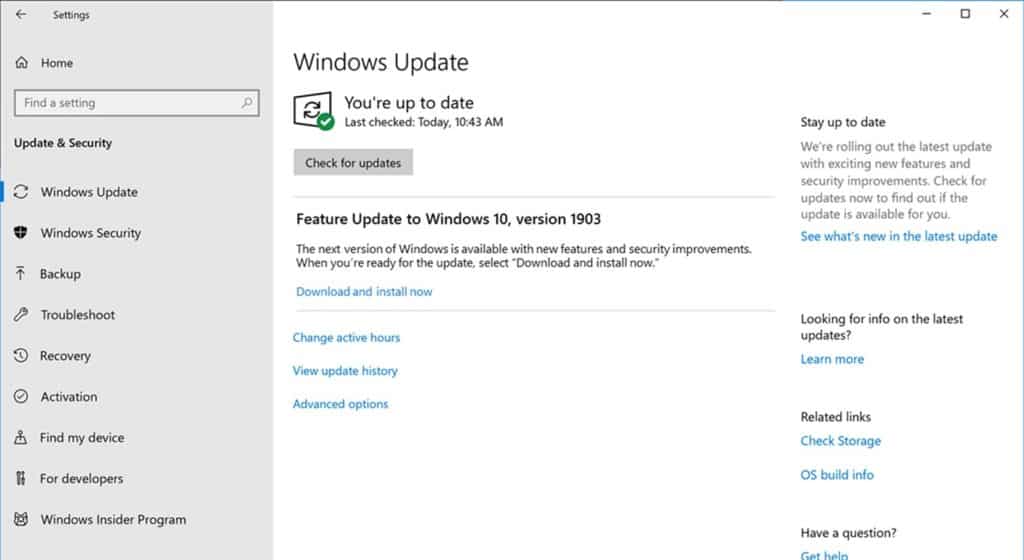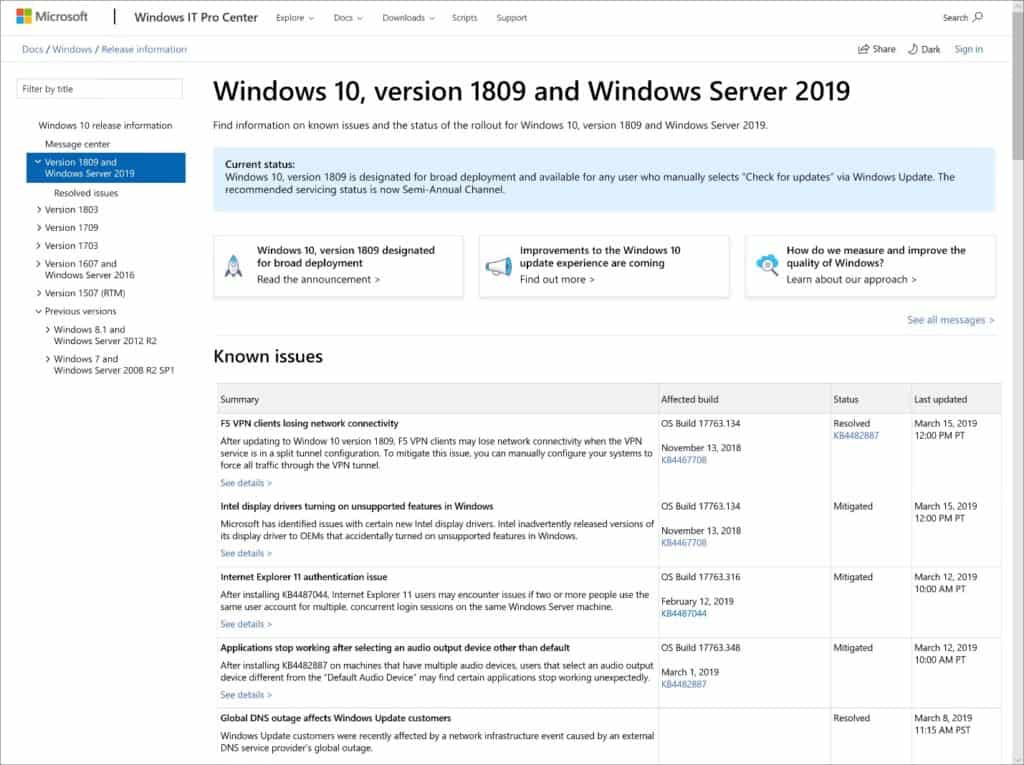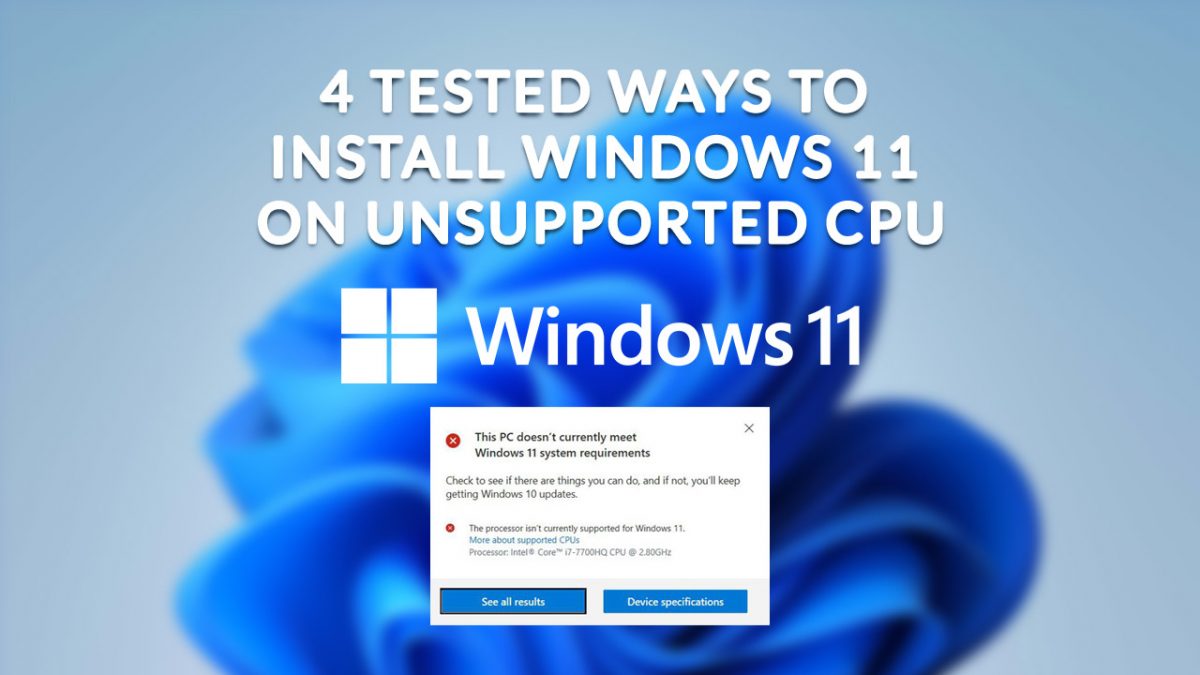Windows 10 May 2019 Update announced, and major update changes

Microsoft announced major Windows Update related changes today; the company wants more time to test the next feature update for Windows 10 and has made the decision to release it at the end of May 2019 instead of March / April 2019. Starting with that release, feature updates won't be downloaded and installed on compatible systems anymore immediately after availability (in other words, they are not forced onto systems immediately after release anymore).
Mike Fortin, Corporate Vice President Windows, explains that Microsoft wants "to be confident in the quality of the May 2019 Update" and that the decision was made to extend the time the update will be tested before release.
The May 2019 Update will be available in the Release Preview Ring starting next week. Microsoft plans to make it available to a broader audience from late May onward (note that this includes admins who use "check for updates" this one last time).
Windows 10 Feature Updates changes
What may be even more interesting from a user's and administrator's point of view is that the company announced a major change in regards to feature updates.
Feature updates were released twice a year previously; when Microsoft deemed that a system was ready for update, it would push out the update to the system automatically. Users could start the update to the new version manually by clicking on the "check for updates" button in the Windows Update interface, or by using other tools to upgrade.
Starting with the May 2019 update, "users will be more in control of initiating the feature OS update" according to Mike Fortin.
Means: Microsoft plans to change how and when feature updates are delivered to (home) customer devices.
The company plans to split feature updates from general update checking on Windows 10 devices that run the May 2019 update or newer versions.

The "check for updates" option won't check for feature updates anymore so that only monthly quality and security updates are downloaded and installed on Windows 10 devices when the button is used by a system administrator.
Windows Update displays when new feature updates are available separately. Administrators may select to download and install these feature updates but they don't have to according to Microsoft so that they may stay on the current version as long as it is supported. Windows 10 version 1803 and 1809 will feature that option "by late May" as well according to Microsoft.
Microsoft says that there won't be any pressure to upgrade until the particular version of Windows 10 reaches end of support. Windows 10 may still notify users when new feature updates are available for the machine.
The May 2019 Update introduces other major update-related changes. Administrators may pause updates for a period of up to 35 days separated into chunks of seven days at a time.
Active Hours, a feature designed to block automatic restarts by Windows Update may adjust the time range based on device usage patterns. The default time period, from 8 a.m. to 5 p.m. worked well for Office workers but not so well for home use.
New Windows release health dashboard

A new Windows release health dasbboard will be released in April 2019 to provide system administrators and users with "near real-time information on the current rollout status and known issues (open and resolved) across both feature and monthly updates".
Details for each Windows 10 version will be represented on one page that can easily be searched by keyword, including important announcements, new blog posts, service and support updates and other news.
Closing Words
The changes make a lot of sense. Microsoft needs to get the May 2019 Update right the first time it is released to avoid another feature update release disaster. The Windows 10 version 1809 feature release went terribly wrong which delayed the full rollout of the new version of Windows 10.
Delaying the release for some additional testing is the right decision; most users, admins and companies would not mind, probably, if the testing would even take longer than that provided that the final release version is as stable as it can be.
Removing feature updates from the check for updates functionality and no longer enforcing the installation of feature updates when they become available are two important steps as well to improve reliability and quality.
While I would like to have seen a reduction to one feature update per year instead of two, the changes are a step in the right direction.
Now You: What is your take on all of that?


















Windows update now stuck in Bios. Nothing gets me out of it. Its is supper dumb.
when nadella took over ms changed from for the people to for the money, that guy and that pajit fcc douche bag can piss off in hell together.
@ 420
Agree. This major update change in Win 10 1903 or May 2019 Update is M$ admitting that Nadella’s blueprint for the new Win 10 RTM 1507 “Windows As A Service” in 2015 was faulty and buggy. Nadella should be fired for firing the Windows Testing Division in 2014 = firing of 150 professional Windows testers and mothballing of 1200 lab computers.
Windows Update for Win 7/8.1 was fine or not broken before 2014 until Nadella came along to fix and break what wasn’t broken.
@ 420
Yes, agree. Nadella probably wanted every Win 10 user to be as miserable as his disabled son and himself = his personal vendetta against the heavens for giving him an only and disabled son.
……. Linux users are a happier lot.
.
P S – Indian culture is very patriarchal = sons are spoiled rotten and treated like royalty and daughters are treated like servants. In Indian Hindu marriage, the girl’s family has to give costly dowry to the boy’s family. Nadella must have gotten a big wedding dowry. His disabled son will get ….?
I can no longer be bothered to attempt to follow and understand Microsoft’s continually changing support, update, and upgrade policies. I have that luxury because by the time Windows 7 hits end of life, I will have switched completely to Linux. I’m reasonably confident that whatever distro I end up using (I’ve winnowed my short list down to four), it will be more stable, less buggy, and more coherently managed than Windows 10.
https://news.softpedia.com/news/city-council-blasts-microsoft-for-killing-off-windows-7-525577.shtml
A Softpedia news article about the Bath and North East Somerset Council states that the Council’s coming upgrade to Win 10 will be EOL’ed in 2025 = the Council will need to pay M$ again for new Win 10 licenses in 2025. Does this means all of today’s Win 10 Home & Pro users will have to pay M$ again for new licenses in 2025.?
……. And if they won’t pay they will no longer receive upgrades from M$ after 2025. Eg in 2025, pay M$ US$139 for a Retail Win 10 Home license and US$199 for a Retail Win 10 Pro license, in order to continue to receive upgrades from M$. Alternatively, consumers may buy new OEM Win 10 computers in 2025 and mothball their EOL’ed Win 10 computers.
Well, M$ did state that the EOL for Win 10 was 2025 when it was newly launched in July 2015. It will seem unfair for consumers who will buy a new OEM Win 10 Home or Pro computer in 2024 and then one year later in 2025, they will be forced to pay M$ again for a new license.
Win 10 Ent users won’t be affected because they are usually running on Software Assurance or subscriptions which guarantee perpetual upgrades from M$ for extra payments, eg a 10-year Win 10 Ent E3 subscription will cost US$840.
……. A few may be running the twice-as-costly 10-year Win 10 Ent LTSC edition, eg Win 10 Ent LTSC 2019 will EOL in 2029.
Like the 2020 EOL for Win 7, come the 2025 EOL for Win 10, things will be quite interesting for Win 10 Home & Pro users.
They are mercyless in destroying a once fine product. But the big flock will follow without doubt. Watch and enjoy.
Note that this still doesn’t let 10 Home users defer quality updates, which (IMO) should be set to like 15 days or so in Pro and above versions so you don’t get hit with cumulative updates until the kinks are ironed out.
The hackers prefer W10 before the old versions that don’t get any updates any longer. The hackers i know say that W10 leaks as h*** thanks to all bugs/low quality updates and is the easiest Windows yet to hack.
(Now any payed Microsoft fanboy/girl will go nuts and tell me that isn’t the way !)
IDK, they’ve been swarming Tesla articles lately.
Two ISO update per year is a complete madness itself. Just my small opinion about this fact.
https://www.zdnet.com/article/microsoft-is-making-big-windows-10-update-changes-starting-with-the-may-2019-release/
According to Mary Jo Foley at Zdnet, from end May 2019 onward, Win 10 Home users can choose to remain on a Version for about 18 months before being forced auto-upgraded by M$ to the latest Version. Previously, Win 10 Home users could only remain on a Version for 6 months before they were forced auto-upgraded by M$ to the latest Version every 6 months, as unpaid beta-testers to service her VIP customers, ie the Pro & Ent users.
In effect, it seems most beta-testing of new Versions will be moved from Win 10 Home users to Windows Insiders Release Preview Ring and M$-employees by increasing the time of testing by about 1 month before the new Version is released to the general public via Windows Update.
……. I doubt this move by M$ will reduce the bugginess of new Win 10 Versions like buggy 1809. This move may only reduce the upgrade pains of Win 10 Home users.
Windows Release Health Dashboard?
OMG! Too funny!
Well, Maybe MS is listening, one can only hope. Employees are revolting, attacking the company, google is moving on edge, all good things!
I really hope those who came up with that stupid “windows as a service” fiasco, all of them, have been fired. Treating customers the way windows update has is inexcusable.
Is mozilla next? No more deliberate scheduled destruction of firefox?
During any given week MS still could be the biggest company in US, almost a trillion dollars market cap. HOW?
This is what I would like:
When your current Windows 10 version support ends, Windows Update will update you to the next version of Windows 10 in sequence, not to the latest version of Windows 10.
Delaying is good.
I should have delayed.
I’m on 1803, tried installing the 1809 update today and got a BSOD in the middle of it.
Amazin.
Protip: Don’t click the check update button
It has been difficult to accept the reality, but it is already late in my case, transition made to linux mint.
On the other hand we hope to have if you also get off the donkey with invasive telemetry, there should be a privacy option that allows you not to accept telemetry in any way and to be deactivated.
As well as the hidden kb with the services that send data collapsing the performance in the teams!
I also think that it may be a temporary maneuver to attract users of w7 and w8, and later change the updates again, of microsoft worse things have been seen!
M$ should just re-form the Windows Testing Division in order to make real QUALITY updates, ie not non-fully-tested buggy updates.
M$ should make the 10-year Win 10 LTSC edition available to home-users or consumers at a reasonable price. Only the few bleeding-edge users like to be forced auto-graded by M$ twice or once a year.
……. Eg 95% of Ubuntu users chose the 5-year LTS Release edition(eg Ubuntu 16.04). Only 5% chose the “Rolling Release” edition(eg Ubuntu 16.10, Ubuntu 17.04 and so on).
“ie not non-fully-tested buggy updates.”
I’ve always been under the impression the point in testing was to determine if you pass. If not, address failures and test again.
Maybe four decades in engineering has been a dream. Maybe all the products that really work, that save lives, propel planes, control autos, etc., I’ve developed, with many others of course, are illusory.
Imagine if google with their typical head up their tech corporate attitude of telling customers what they want hadn’t backed out of that military drone image analysis project.
I already give to anyone IRL who’s insisting in having Windows 10, the LTSB 1607 ISO =)
Never had questions afterwards about why there are ads in start menu, or why the PC spontaneously restarts, etc… I think it’s the better Windows 10 release, by far.
yeah but the difference between 1607 ltsb and 1809 ltsc is night and day, ltsc is a pile of crap.
@ 420
Win 10 Ent LTSC 2016(1607) is like Win 7.
Win 10 Ent LTSC 2019(1809) is like Win 8.1.
The main point people choose to use the LTSC edition is NO FORCED AUTO-UPGRADES by M$ for up to 10 years, similar to using Win 7 = no buggy upgrades from M$ to crash your computer = peace of mind.
Are you saying that Win 7/LTSC is a pile of crap and Win 10 (Home) is not.?
no, I am saying that 1809 ltsc is a pile of crap compared to 1607 ltsb in my useage and my opinion, it uses like twice as many resources and 50% more ram and does not do anything extra I need or want for that expensive useage.
Windows XP/7/8.1 still got updates more right – small, compact, can manually select and install or reject and forget. A concept they can no longer be bothered with because they need to force it somehow “gently” now but still force it to keep Windows relevant. Can’t have people settling for “good enough”.
@Jeff, that’s because they have become lazy over the years. Look how ugly Windows 10 looks, how it lacks previous features and freedom for customization to make it your own. Now the updates can’t be avoided, because it’s easier for them to force it down your throat. They don’t have a quality assessment team anymore that roots out the bugs and issues in Windows 10. They fired those people and created the Insider program, where eager Microsoft/Windows fanboys can become lab rats and test new builds and discover the issues free of charge (for Microsoft). But it has been proven ineffective, because for as long as the Insider program existed, every release has been a buggy mess and had to be delayed for another 6 months or so…
Nothing is as good as XP and 7. I still use Windows 7 and don’t inted to change that unless my PC breaks and I need a new one or I want to play a game that requires Windows 10 and it will never be playable on Windows 7. I also miss XP a lot, that blue Luna theme, the green Bliss wallpaper… sure I can use 3rd party themes to achieve that look on Windows 7, but it just isn’t the same as the real thing.
I kinda feel like back around that period 2000 – 2010, people didn’t have issues with their Windows OS, it just worked and they focused on their work/gaming or whatever, whereas nowadays, it’s all about issues, builds, broken updates, delays, rollbacks, deferring from updates, etc.
I still will not press “check for updates”, even after that update, until I see what happens to others who do so. I am not anxious to become a guinea pig for something which may not work as advertised.
Coming from a fresh 1803 install, I BSOD 3 times in a row.
I had to disable the update service to be able to keep on using the system.
Now I have to do a fresh install of 1903.
Sucks.
I don’t understand… on one hand, the article says people can defer installing new feature updates until the current one isn’t supported anymore. And then it says people can defer them for 35 days. So, which is it?
Both are correct. Windows Update won’t force Feature Updates on your system anymore unless the installed version is about to run out of support.
You may use the pause update option to pause updates, any update, for up to 35 days. That’s the way I understand it.
Sergey just put up a nice article on delaying updatees, quality and feature, and at the bottom is how to do it with registry tweaks on windows 10 home for the 30 and 365 days pro user have right now.
https://winaero.com/blog/delay-windows-10-version-1903-may-2019-update/
From another article I read, I think it’s:
– Feature updates: Pause til the current one is unsupported
– Monthly updates: Pause for up to 35 days
Or maybe that’s what you meant :)